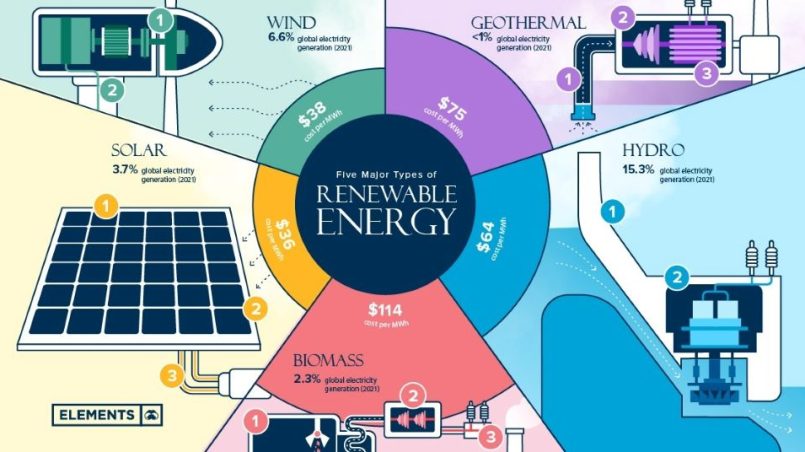Key Takeaways:
Renewable energy is a cornerstone in achieving sustainable infrastructure. It promotes environmental conservation, economic development, and energy security. By integrating renewable energy sources into infrastructure projects, communities can benefit from reduced environmental impact, lower energy costs, and enhanced resilience.
Introduction
The need for sustainable infrastructure driven by renewable energy is growing in importance as environmental deterioration and climate change become more widely recognized. Renewable energy derived from the sun, wind, water, and biomass provides a clean, plentiful, and sustainable substitute for fossil fuels. By using these natural resources, society may lower carbon emissions, stop pollution, and construct socially and economically responsible and environmentally benign infrastructure. This article highlights how renewable energy is pivotal in driving sustainable infrastructure growth, examining its environmental, economic, security, and technological benefits.
Environmental Benefits of Renewable Energy
The outstanding environmental advantages of renewable energy are among its most significant effects. Since renewable energy sources don’t directly emit greenhouse gases like fossil fuels, they significantly reduce air pollution and mitigate the consequences of climate change. For example, projects such as renewable energy projects Imo State have demonstrated substantial reductions in carbon emissions by transitioning from conventional to renewable energy sources. Moreover, renewable energy facilities require less water than traditional power plants, contributing to conserving this precious resource.
By incorporating renewable energy into infrastructure projects, cities and countries can develop harmoniously with nature. Solar panels, wind turbines, and hydroelectric systems integrate seamlessly with green building practices, reducing the ecological footprint of new constructions. In this way, renewable energy becomes an energy source and a guiding principle for sustainable development, ensuring that infrastructure growth does not come at the cost of environmental degradation.
Economic Growth Through Renewable Energy
The economic implications of renewable energy are substantial, offering opportunities for job creation, investment, and long-term savings. The renewable energy business has grown quickly, with millions of jobs globally in production, installation, maintenance, and other areas. These opportunities often extend to local communities, driving regional development and reducing economic disparities.
Furthermore, renewable energy projects attract significant investment as governments and private sectors recognize the potential for returns. Deploying renewable technologies can lower energy costs by providing more affordable and stable energy sources over time. Unlike fossil fuels, which are subject to volatile price swings, renewable energy systems benefit from low operational costs once installed. This price stability can foster economic resilience, making renewable energy attractive for businesses and governments looking to stabilize and grow their economies sustainably.
Energy Security and Resilience
Due to a fluctuating global energy landscape, energy security has become a major concern for countries worldwide. Renewable energy offers a solution that diversifies energy sources and decreases dependency on imported fuels. By generating electricity locally, countries can insulate themselves from geopolitical tensions and supply disruptions, enhancing national security and energy independence.
Moreover, renewable energy systems enhance infrastructure resilience by decentralizing energy production. Distributed energy generation, such as rooftop solar installations and wind farms, reduces the risk of widespread outages, providing reliability even during extreme weather events or other disruptions. Communities powered by renewable energy resources can recover more quickly from natural disasters, ensuring a stable energy supply to support crucial infrastructure and services.
Technological Advancements and Innovation
The push toward renewable energy has spurred significant technological advancements and innovations, leading to improved efficiency and performance of renewable systems. For example, advancements in battery storage technology have addressed one of renewable energy’s primary limitations—its variability. These technologies allow the storage of excess energy generated during peak production periods, providing a steady and reliable energy supply even when natural conditions fluctuate.
Additionally, innovative grid technologies are revolutionizing energy management, optimizing the distribution of renewable energy to match demand efficiently. These innovations create more responsive and adaptive energy systems that can better integrate diverse energy sources while minimizing waste and maximizing use. As renewable energy technologies continue to evolve, they will unlock new possibilities for sustainable infrastructure development, enabling smarter, greener cities of the future.
Integration of Renewable Energy in Urban Planning
Urban planning is essential for fully utilizing renewable energy sources for sustainable development. Cities worldwide increasingly recognize the importance of integrating renewable energy systems into urban landscapes. Urban planners leverage solar, wind, and geothermal energies to create smart cities that utilize energy efficiently while minimizing environmental impact.
Incorporating renewable energy into urban planning supports the transition toward sustainable infrastructure and enhances quality of life. Homes, offices, and public buildings equipped with solar panels, for instance, reduce reliance on grid electricity and contribute to cleaner air. Paired with renewable energy, green infrastructure offers numerous advantages, including reduced urban heat island effect, enhanced biodiversity, and improved resilience to climate change impacts.
Conclusion
Making the switch to renewable energy is not just necessary for the environment; it is also a driving force behind the expansion of sustainable infrastructure. By embracing renewable energy, society gains economically, environmentally, and socially. Renewable energy drives innovation, boosts economies, and fosters resilient communities facing environmental and economic challenges. Adopting renewable energy opens the door for infrastructure supporting future generations while protecting our planet as the globe shifts to greener and cleaner options.



